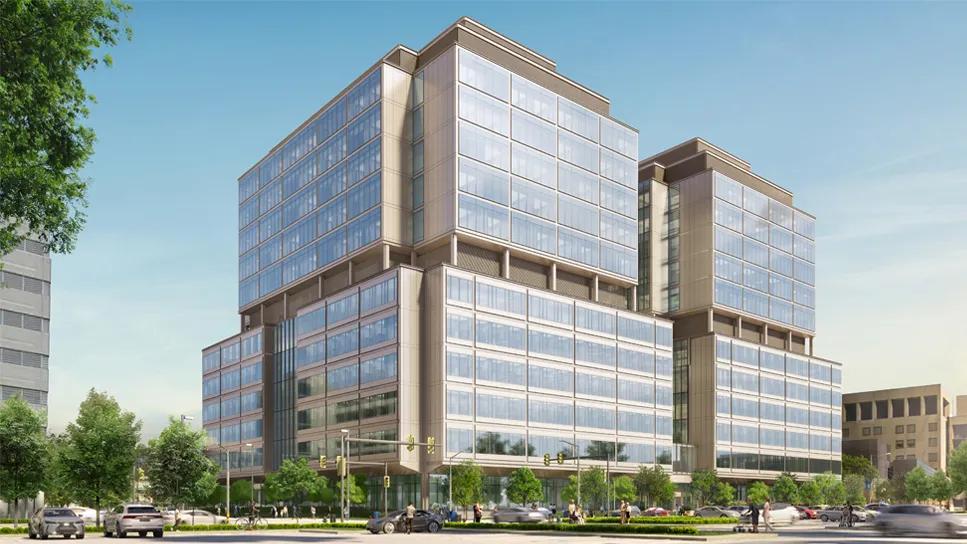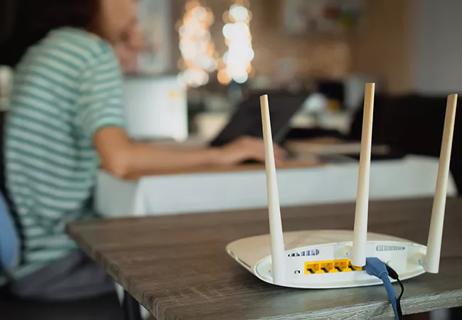Advanced connectivity and technologies build on a foundation of teleneurology leadership

Earlier this year, the final steel beam was hoisted atop Cleveland Clinic’s forthcoming 1 million-square-foot Neurological Institute building, scheduled to open for patient care in early 2027. The facility will be dedicated to the outpatient and inpatient care of disorders of the brain, spine and nerves.
Advertisement
Cleveland Clinic is a non-profit academic medical center. Advertising on our site helps support our mission. We do not endorse non-Cleveland Clinic products or services. Policy
The building will expand the physical infrastructure dedicated to neurological care on Cleveland Clinic’s Main Campus, initially housing 210 inpatient rooms (to be expanded to 300), 120 outpatient exam rooms, 36 neurological ICU beds and 14 operating rooms. Imaging, infusion, physical/occupational therapy and surgical services will be offered, complemented by research labs to provide new insights into brain function and develop more effective therapies for neurological conditions.
“This will be the largest and most technologically advanced neuroscience-focused facility in the world,” says Cleveland Clinic Neurological Institute Chief Andre Machado, MD, PhD. “It will house a highly advanced and integrated team with a dual mission: to provide the best care possible today while discovering the neurological care of tomorrow. We believe its integration of clinical care with research and education will attract the finest neuroscience talent to serve at Cleveland Clinic.”
A multidisciplinary team of physicians, nurses, physical therapists, engineers and others has been involved in the building plans to ensure an ideal blend of design and functionality. The building will be equipped throughout with state-of-the-art technology intended to put Cleveland Clinic at the forefront of what Neurological Institute leaders call the “3 D’s” — digitization, discovery and distance health — in service of exceptional and transformative neurological care.
This article profiles how one of those D’s — distance health — is shaping the new building and will amplify its impact.
Advertisement
Dissemination of neurologic expertise is at the core of the Neurological Institute’s distance health mission. Once the building is operational, its technologies will help standardize clinical excellence and quality in neurological care across other Cleveland Clinic care sites and beyond.
“We will use the capabilities within our new building to democratize access to neurological care by leveraging the expertise of our Main Campus caregivers to enhance medical decision-making everywhere,” says Dr. Machado. “A patient can be admitted to a Cleveland Clinic regional hospital and connect via distance health to the new building and the subspecialty experts there.”
This connection will take the form of both direct-to-patient and physician-to-physician collaboration — two areas where Cleveland Clinic has a long track record of teleneurological innovation.
In the realm of distance health-enabled direct care, Cleveland Clinic has for years been a national leader in both the volume and the breadth of subspecialty teleneurology outpatient visits offered. But nowhere has Cleveland Clinic built more expertise in distance health-enabled direct care than in telestroke offerings. Since launching its telestroke program in 2011, Cleveland Clinic has provided 24/7 access to stroke-trained neurologists to remotely evaluate patients and direct thrombolytic therapy and other management strategies at various facilities inside and outside the Cleveland Clinic health system. The program leverages mobile two-way videoconferencing and networked imaging systems to bring subspecialty stroke expertise to patients without immediate physical access to stroke specialists.
Advertisement
“We have been on the cutting edge of telestroke care for years, extending the expertise from our Main Campus across a large geographic area to benefit patients throughout northern Ohio, in Florida and beyond,” says M. Shazam Hussain, MD, Director of Cleveland Clinic’s Cerebrovascular Center. “The technologies of the new building will allow us to build from that high baseline and use distance health to offer direct care in additional ways.” He cites the example of the neurological ICU, where advanced videoconferencing technology can allow an expert to remotely evaluate a patient in the middle of the night, interacting with family members at remote locations as needed.
Similarly, the building’s distance health features will enable expanded physician-to-physician collaboration. For years Cleveland Clinic has provided remote emergency department and inpatient neurology consultations, both to its regional hospitals and to external hospitals that contract for expert neurological consultation. This involves real-time sharing of imaging and electrophysiology findings as well as a dedicated link to electronic medical records. Cleveland Clinic’s centralized epilepsy monitoring efforts offer a prime example of how the new building will enhance these capabilities, notes Imad Najm, MD, Director of Cleveland Clinic’s Epilepsy Center.
“With the technologies we will have in the new building, our epilepsy monitoring services will be much more scalable,” Dr. Najm says. No longer will a hundred computer monitors and screens be needed to monitor 100 patients for seizures, he explains. “We are working with a startup to create algorithms to flag any EEG abnormalities from the various patients we are monitoring at a given time. Any findings of interest will be displayed on a large screen in the new monitoring unit, with the ability to simultaneously display abnormalities from multiple patients if needed. We will be able to provide a reading of any EEG of interest as well as an expert opinion on it based on immediate processing of the data. The algorithmic analysis of the EEGs will be highly scalable, without limits based on screens or sufficient personnel to monitor multiple screens.”
Advertisement
The scalability of this digitized care delivery is made possible in large part by the ability to wire the entire building for maximal modern connectivity from the outset. “The extraordinary connectivity of the building will make for a much more stable digital environment for us to connect with patients and providers outside the building,” Dr. Najm notes.
This will have big dividends for education as well. “We plan to stream our grand rounds to anywhere in the world rather than offer them only locally,” Dr. Najm says. The deep connectivity will also promote opportunities for remote training via virtual or augmented reality systems, even enabling supervision of trainees’ hands-on work. Dr. Najm foresees likely uses for remote attendees of Cleveland Clinic’s school of EEG technology and for training of future technologists at various Cleveland Clinic locations, such as Florida, Abu Dhabi and London, in procedures such as efficient and accurate electrode placement on the scalp.
Another key dividend will be enhanced “systemness” of care, in which technology facilitates interaction across the Cleveland Clinic enterprise, standardizing care and ensuring patients receive top-level expertise regardless of their location within the system. “This involves not just the technology but also the development of protocols and procedures to ensure seamless integration,” says Dr. Hussain, who has helped organize efficient stroke systems of care across the regions served by Cleveland Clinic. “The ability to triage patients effectively and direct them to the most appropriate level of care within the system is an important benefit, ensuring that the specialized expertise at our Main Campus is used efficiently.”
Advertisement
Additionally, the new building’s technologies will also integrate easily with patients’ home and smartphone health-monitoring technologies to allow round-the-clock assessment of certain measures when helpful. “This will make our clinical data collection even richer, and it will enable more effective monitoring of how patients are doing on a daily basis, outside the limited window of appointments they have with us, whether online or in person,” Dr. Machado says.
While not expected to be operational on day 1, the infrastructure of the new building will support the integration of artificial intelligence (AI)-powered systems that could analyze video feeds to detect subtle signs of deterioration in inpatients, such as arm weakness or facial droopiness, and alert on-site staff and remote specialists. “Those applications are still in the exploratory stage, but the building will be equipped to enable such capabilities from the start,” Dr. Hussain explains.
Another longer-term possibility is remote oversight of robotic interventions, such as a complex procedure proctored by a neurosurgeon in Cleveland on a patient in a distant Cleveland Clinic hospital. “This is not a day 1 capability,” Dr. Najm says, “but the new building's advanced connectivity may eventually enable this type of remote participation in procedures to address currently unmet needs.”
Advertisement

Clinicians embrace immersive technology to learn real-world skills

Remote caregivers allow bedside nurses to breathe easier when out of a patient’s room

Phone triage system reduces call backs and delays in care

Mode of delivery does not affect patient satisfaction

Telehealth aids in treatment of fibromyalgia and median arcuate ligament syndrome

Rates of CR eligibility high and internet access low among older patients in rural areas

Combining group telehealth sessions with one-on-one sessions shortens time to follow-up care

Remotely based physicians use telehealth technology to evaluate lower-acuity patients in the ED, express clinic or during an EMS response